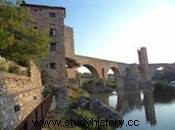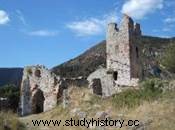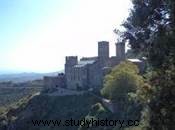 In France, when we talk about tourism in Catalonia, we immediately think of Barcelona, or even the beaches of the Costa Well done. However, Catalonia offers much more, and particularly when you go inland. The Catalan Tourism Agency thus offers tourist routes that allow you to trace the history of Catalonia , until its birth in medieval times. By following these roads, we discover all the links between Catalonia and France, from the Spanish March to the Chemin des Bonshommes taken by the Cathars in flight. Example of a tourist itinerary and possible history in order to get an idea of this journey in the county Pyrenees, from Cardona to Girona via Besalú and Santa Maria de Ripoll, to meet Bishop Oliba and Guifred le Velu…
In France, when we talk about tourism in Catalonia, we immediately think of Barcelona, or even the beaches of the Costa Well done. However, Catalonia offers much more, and particularly when you go inland. The Catalan Tourism Agency thus offers tourist routes that allow you to trace the history of Catalonia , until its birth in medieval times. By following these roads, we discover all the links between Catalonia and France, from the Spanish March to the Chemin des Bonshommes taken by the Cathars in flight. Example of a tourist itinerary and possible history in order to get an idea of this journey in the county Pyrenees, from Cardona to Girona via Besalú and Santa Maria de Ripoll, to meet Bishop Oliba and Guifred le Velu…
From Món Sant Benet to Cardona (1 st day)
The first stage of the route passes through the Món (“world”) Sant Benet (Sant Fruitós de Bages), about 70 km northwest of Barcelona. We discover a monastery founded in 950, where the relics of Saint Valentine would have been deposited before they were destroyed by the Saracens in 1125. First Romanesque (even pre-Romanesque), the style evolved over time. , from the Gothic (under the impulse of the monks of Montserrat) to the Baroque, the influences sometimes mixing as can be seen in the crypt dating from 1637. The Gothic cloister, unrestored but very well preserved, is magnificent. The places are remarkably highlighted by a museography using recent technologies, first offering a history of the monastery in the form of a film projected on the wall of the church, then visual and sound animations throughout the visit.
About thirty kilometers to the north, we enter the viscounty of Cardona where, in medieval times, the lords of salt reigned, which reached their peak in the 15th century ( they were nicknamed “the kings without crowns”). The position of Cardona, long on the border between Al Andalus and the Marches of Spain (future Catalonia), prompted the lords to build a castle, now transformed into a parador. In the small town of Cardona, we first visit San Miguel Church , consecrated in the 13th century, and where you can admire, among other things, 15th century altarpieces depicting the martyrdom of Saint Ursula. Then, perched 525m on the hill, the castle of Sant Vicenç , its so-called tower of the Mignonne, and its Romanesque church consecrated in 1040. The site is impressive and allows you to contemplate the whole surrounding region at 360 degrees.
From Gósol to Besalú, passing through Ripoll (2 e day)
The county of Berga, always a little further north, is according to the history of medieval Catalonia that of the "viscount troubadour", Guillaume de Berguedà, who, in the 12th century, did not hesitate to confront Alfonso I of Aragon, but who distinguished himself as much by his taste for war as by his artistic production. This county of Berga is crossed by the Chemin des Bonshommes which extends over more than 200 km between Montségur (France) and the ancient medieval village of Gósol. This path was taken between the 12th and 14th centuries by the Cathars fleeing the persecutions suffered in France, and who wished to take refuge in independent Catalonia. It is now a hiking and mountain biking trail. The village of Gósol (a name that dates back to the 9th century) has kept on its hill the ruins of the church of Santa Maria and the medieval castle. The place is also known for hosting Picasso at the beginning of the 20th century. Not far away stands the impression Pedraforca and its 2507 m.

Taking the road east again, just over 50 km from Gósol, we arrive at Ripoll for the visit of theSanta Maria monastery , built by the historical (even legendary) founder of Catalonia, Guifred le Velu, around 880. Unfortunately, Nature and history have seriously damaged the place. An earthquake in the 15th century destroyed most of the Romanesque and Gothic monastery, with the exception of the magnificent portal (dating from the 11th-12th centuries) and part of the cloister (12th century), and the civil wars of the 19th century didn't fix things. The abbey, however, was rebuilt "Romanesque" at the end of the 19th century, under the direction of Elies Rogent, and remains impressive.
Continuing our route to the east, we discover the little jewel of the region:the county town of Besalú . We first notice its charming medieval bridge dating from the 11th century, then, in the city, the Jewish quarter and the monastery of Sant Pere , founded in 977 and whose church was consecrated in 1003. The small town has other equally remarkable places, such as the hospital of Sant Julià (12th century) and the church of Sant Vicenç (10th-15th centuries), and it is very pleasant to walk there, at night or early in the morning, on the banks of the riu fluvià.
From Sant Pere de Rodes to Girona (3 e day)
Returning to the Costa Brava, we see at the end of a small road the majestic monastery of Sant Pere de Rodes, facing the sea, and overlooked by the remains of the castle Sant Salvador . The panorama and the site are impressive. The monastery itself is just as interesting, with its splendid 11th century church, its cloister (10th-12th centuries) and its two large towers (one guard, the other being the bell tower). Its construction on the terrace makes the visit original and pleasant. 
Going back down to the valley, we enter Castelló d'Empúries where we visit the Curia and the 14th century medieval prison (where the tourist office is located). The Basilica of Santa Maria (which its founders dreamed of as a cathedral) is in Catalan Gothic style and, inside, impressive baptismal fonts from the 11th century and an altarpiece from the 15th century can be seen. The city, which like Besalú had an important Jewish quarter in the Middle Ages, also retains part of the ramparts from that time.
Fifty kilometers to the south is the "city of Charlemagne":Girona . Indeed, it is supposed to have submitted to the Carolingian in 785 but it seems that he never set foot there. The city is of Roman origin, on via Domitia. Today, it is a large student city, very pleasant, and which has many interesting places to visit. We can cite for example the impressive cathedral, which stands on the highest point of the city, with its Gothic cloister and its vault 37 m high and 26 m wide. In the museum, you can admire the Tapestry of Creation (11th-12th centuries). Do not hesitate to walk along the ramparts, then in the city, to discover other sites such as the church of Sant Feliu .
Vic and the Episcopal Museum (4 e day)
The last day of our journey takes us a bit inland again, to Vic. Ancient Roman city of the 5th century, it was refounded by the famous Guifred le Velu in the 9th century. The no less famous Oliba, great-grandson of Guifred, became bishop of Vic in 1018 thanks to the support of Ermessende, wife of Raymond Borrell. However, the city today has more modern (and Baroque) than medieval sites, with the exception of ramparts, remains of the 11th century count's palace and certain parts of the cathedral, such as the six-storey bell tower (11th century). century). Cathedral decorated in the 20th century by the impressive paintings of José Maria Sert.
In Vic, you should not miss the Episcopal Museum. Opened in 2002, it has splendid pieces, remarkably highlighted by a simple museography which should inspire many other museums or exhibitions. This is particularly the case for all the works of the Romanesque and Gothic periods.The routes of the county Pyrenees (Catalonia)
The route taken here is not exhaustive, it represents only a tiny part of all the sites to be discovered in historic Catalonia. The Catalan Tourism Agency (see links below) offers several routes to discover the history of Catalonia, including two main ones, each of five days, one from Empordà to the Boí Valley, the other from the Boí Valley to Girona, respectively north and south routes. There is also nothing to prevent you from traveling through the counties (eleven in number) one by one, spending one or more days there.
Travelling the routes of county Catalonia is therefore, in conclusion, a very good idea for any lover of cultural and historical tourism. Especially since the region also allows you to enjoy more “classic” tourist activities such as hiking, discovering gastronomy and swimming on the Costa Brava. It's not just Barcelona in Catalonia!
- The county Pyrenees, discovery of Catalonia in the Middle Ages . For further information:
Catalonia Information Point in France
1 carrer de la fusteria, 66000 Perpinyà. This email address is being protected from spambots. You must activate JavaScript to view it. Tel:04 68 62 74 67
